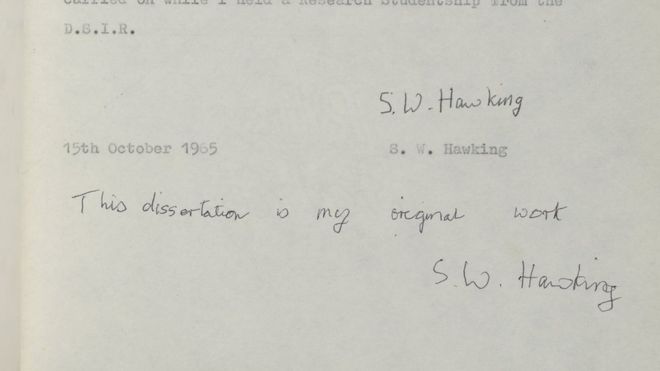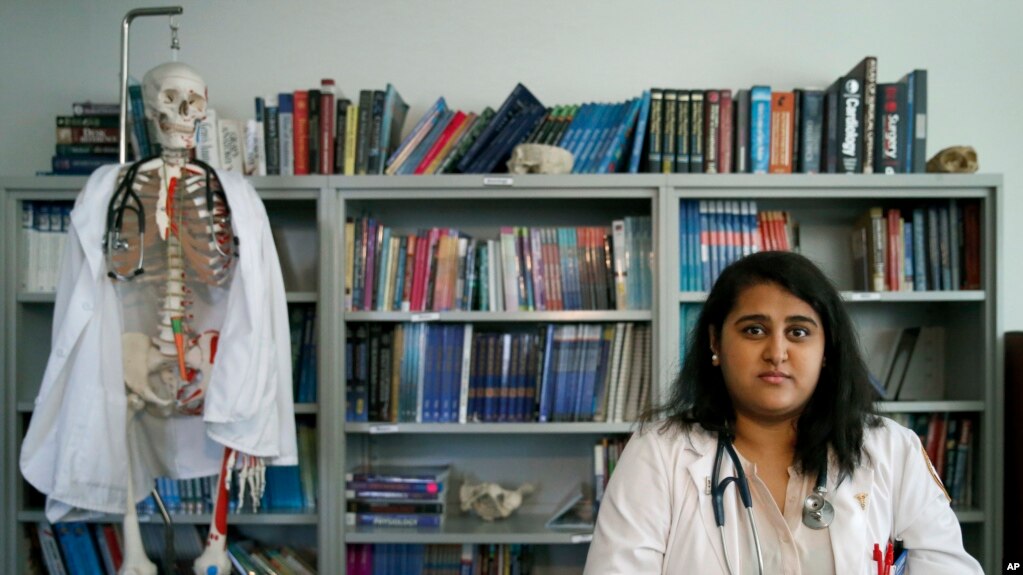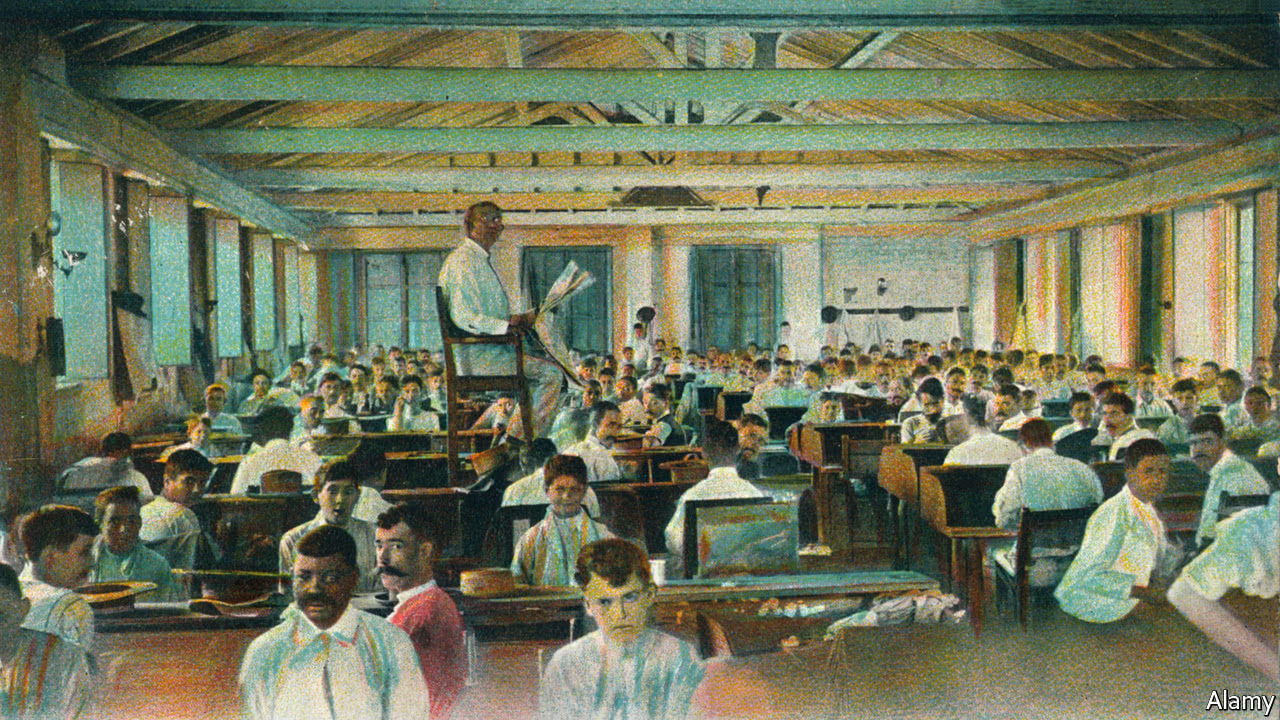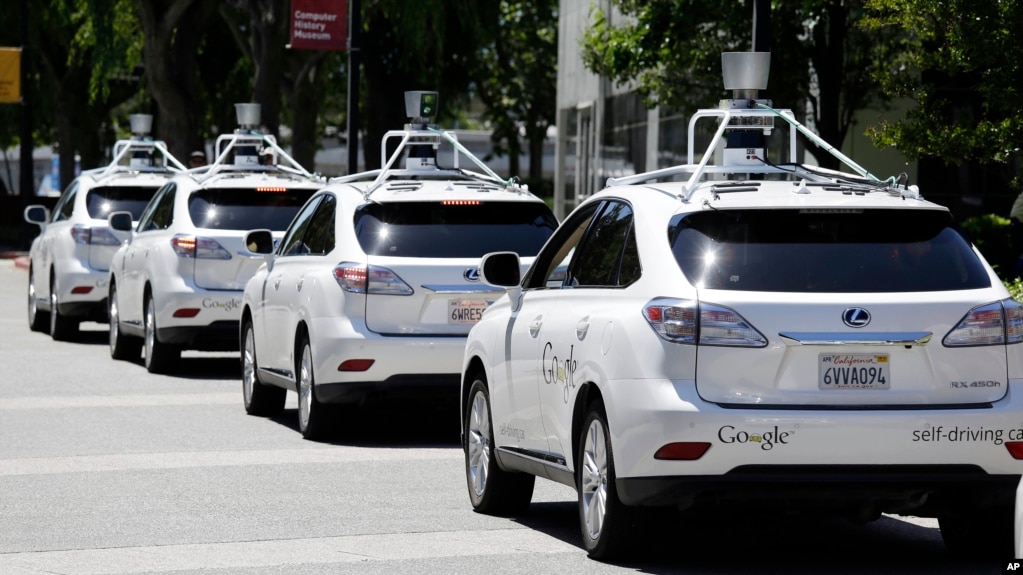You can also watch the video by clicking on the Play Button
10/29/2017
10/25/2017
Venice Marathon (audio)
You can also listen to the audio file by clicking on the Play Button
You can also watch the video by clicking on the Play Button
10/24/2017
Hawking's thesis crashed Cambridge's website (audio)
 |
| CAMBRIDGE UNIVERSITY/STEPHEN HAWKING |
Stephen Hawking
- Born 8 January 1942 in Oxford, England
- Earned place at Oxford University to read natural science in 1959, before studying for his PhD at Cambridge
- By 1963, was diagnosed with motor neurone disease and given two years to live
- Outlined his theory that Black holes emit "Hawking radiation", in 1974
- Published his book A Brief History of Time in 1988, which has sold more than 10 million copies
- His life story was the subject of the 2014 film The Theory of Everything, starring Eddie Redmayne
You can also listen to this audio file by clicking on the Play Button
10/23/2017
Argentina's Election Results
 |
| President Mauricio Macri of Argentina sharing a selfie with a supporter after casting his vote in midterm elections in Buenos Aires on Sunday. CreditNatacha Pisarenko/Associated Press |
BUENOS AIRES — The governing coalition of President Mauricio Macri of Argentina won decisive victories in key districts across the country in midterm elections Sunday that were widely seen as a referendum on the center-right leader’s first two years in office.
The election sweep strengthens Mr. Macri’s ability to carry out economic changes he says are necessary to improve the country’s economy, and the results automatically position him as a candidate for re-election in 2019.
In the closely watched province of Buenos Aires, where the Senate candidate aligned with Mr. Macri, Esteban Bullrich, faced off against Mr. Macri’s predecessor and political rival, former President Cristina Fernández de Kirchner, the governing coalition won by four percentage points.
“Today, the winner wasn’t a group of candidates nor a party. Today the winner was the certainty that we can change history forever,” a beaming Mr. Macri said at his campaign headquarters before he danced on stage alongside his wife, Juliana Awada, and key members of his coalition.
In Senate contests, the party with the most votes wins two seats, while the runner-up gets one, meaning that Mrs. Kirchner will get a seat in the chamber anyway. On Sunday night, she declared herself the leader of the opposition in attacking the Macri government.
“We believe in the need to unite all the different political forces that believe this political and social model of austerity will only cause pain to most of the population,” Mrs. Kirchner said.
The center-left Mrs. Kirchner has said Mr. Macri’s policies would hurt the poor and middle class.
In Sunday’s elections, Argentines voted on nearly half the seats in the Chamber of Deputies, the lower house of Congress, and for a third of those in the upper house, the Senate.
Although no party will get an outright majority in the legislature, the strong performance of Mr. Macri’s coalition means it will pick up several seats in both chambers.
Final del formulario
In the city of Buenos Aires, long Mr. Macri’s stronghold, his coalition’s ticket received more than half the vote.
“This victory is a huge recognition and a huge dose of support for the change that President Mauricio Macri is leading,” said the mayor of Buenos Aires, Horacio Rodríguez Larreta.
This results showed Mr. Macri’s young coalition gaining support across the country, including in some surprising corners that have long been under the sway of Peronism, the dominant force in Argentine politics for decades.
In the northern province of Salta, the charismatic Peronist governor, Juan Manuel Urtubey, who had been seen as a possible successor for Mrs. Kirchner to lead the opposition, lost to Mr. Macri’s coalition.
Mr. Marci’s allies seized on the results as evidence of a changing political climate in Argentina.
“We are the generation that will change, for real and forever, this province,” said a visibly emotional María Eugenia Vidal, who shocked pundits in 2015 when she was elected governor of the province of Buenos Aires. She has since emerged as one of the most popular politicians in the country.
10/22/2017
USA Medical Students in Limbo
 |
| Zarna Patel a third year student who was brought to the U.S. from India as a 3-year old without any legal documents |
Medical student Alejandra Duran Arreola dreams of becoming an OB-GYN in her home state of Georgia, where there’s a shortage of doctors and one of the highest maternal mortality rates in the U.S.
But the 26-year-old Mexican immigrant’s goal is now trapped in the debate over a program protecting hundreds of thousands of immigrants like her from deportation. Whether she becomes a doctor depends on whether Congress finds an alternative to the Deferred Action for Childhood Arrivals program that President Donald Trump phased out last month.
Arreola, who was brought to the U.S. illegally at age 14, is among about 100 medical students nationwide who are enrolled in DACA, and many have become a powerful voice in the immigration debate. Their stories have resonated with leaders in Washington. Having excelled in school and gained admission into competitive medical schools, they're on the verge of starting residencies to treat patients, a move experts say could help address the nation’s worsening doctor shortage.
“It's mostly a tragedy of wasted talent and resources,” said Mark Kuczewski, who leads the medical education department at Loyola University’s medical school, where Arreola is in her second year. “Our country will have said, ‘You cannot go treat patients.’”
The Chicago-area medical school was the first to openly accept DACA students and has the largest concentration nationwide at 32. California and New York also have significant populations, according to the Association of American Medical Colleges.
DACA gives protection to about 800,000 immigrants who were brought to the U.S. as children and who otherwise would lack legal permission to be in the country. The immigrants must meet strict criteria to receive two-year permits that shield them from deportation and allow them to work.
Then-President Barack Obama created DACA in 2012. Critics call it an illegal amnesty program that is taking jobs from U.S. citizens. In rescinding it last month, Trump gave lawmakers until March to come up with a replacement.
Public support for DACA is wide. A recent poll by The Associated Press-NORC Center for Public Affairs Research showed that just 1 in 5 Americans want to deport DACA recipients.
Medical students such as Arreola are trying to shape the debate, and they have the backing of influential medical groups, including the American Medical Association.
“It's mostly a tragedy of wasted talent and resources,” said Mark Kuczewski, who leads the medical education department at Loyola University’s medical school, where Arreola is in her second year. “Our country will have said, ‘You cannot go treat patients.’”
The Chicago-area medical school was the first to openly accept DACA students and has the largest concentration nationwide at 32. California and New York also have significant populations, according to the Association of American Medical Colleges.
DACA gives protection to about 800,000 immigrants who were brought to the U.S. as children and who otherwise would lack legal permission to be in the country. The immigrants must meet strict criteria to receive two-year permits that shield them from deportation and allow them to work.
Then-President Barack Obama created DACA in 2012. Critics call it an illegal amnesty program that is taking jobs from U.S. citizens. In rescinding it last month, Trump gave lawmakers until March to come up with a replacement.
Public support for DACA is wide. A recent poll by The Associated Press-NORC Center for Public Affairs Research showed that just 1 in 5 Americans want to deport DACA recipients.
Medical students such as Arreola are trying to shape the debate, and they have the backing of influential medical groups, including the American Medical Association.
Arreola took a break from her studies last month to travel to Washington with fellow Loyola medical student and DACA recipient Cesar Montolongo Hernandez to talk to stakeholders. In their meetings with lawmakers, they framed the program as a medical necessity but also want a solution for others with DACA.
A 2017 report by the Association of American Medical Colleges predicts a shortfall of between about 35,000 and 83,000 doctors in 2025. That shortage is expected to increase with population growth and aging.
Hernandez, a 28-year-old from Mexico simultaneously pursuing a Ph.D., wants to focus his research on early detection of diseases. His work permit expires next September, and he's worried he won't qualify for scientific research funding without the program.
A 2017 report by the Association of American Medical Colleges predicts a shortfall of between about 35,000 and 83,000 doctors in 2025. That shortage is expected to increase with population growth and aging.
Hernandez, a 28-year-old from Mexico simultaneously pursuing a Ph.D., wants to focus his research on early detection of diseases. His work permit expires next September, and he's worried he won't qualify for scientific research funding without the program.
“I've shown I deserve to be here,'' said Hernandez, who met with Illinois Sen. Dick Durbin, a Democrat who’s called for Congress to quickly pass a replacement for DACA.
For Arreola it's about returning to the state she's called home since she was 14 and giving back to areas in need of doctors.
“My family is from there; I know those people,” Arreola said. “Those are the people that inspired to really give this a push.”
For Arreola it's about returning to the state she's called home since she was 14 and giving back to areas in need of doctors.
“My family is from there; I know those people,” Arreola said. “Those are the people that inspired to really give this a push.”
Among those Arreola met with were policy staff for Georgia Republican Sen. Johnny Isakson, who believes the Obama program was “an overreach of executive power” but also wants Congress to write a plan to protect DACA recipients.
Medical school administrators say the immigrant students stand out even among their accomplished peers: They're often bilingual and bicultural, have overcome adversity and are more likely to work with underserved populations or rural areas.
“They come with a cultural competency for how to best treat the individuals from their background, whether immigrants or different races and ethnicities,” said Matthew Shick, a government relations director for the Association of American Medical Colleges. “That gets translated over to their peers in education and training.”
Medical school administrators say the immigrant students stand out even among their accomplished peers: They're often bilingual and bicultural, have overcome adversity and are more likely to work with underserved populations or rural areas.
“They come with a cultural competency for how to best treat the individuals from their background, whether immigrants or different races and ethnicities,” said Matthew Shick, a government relations director for the Association of American Medical Colleges. “That gets translated over to their peers in education and training.”
Zarna Patel, 24, is a third-year student at Loyola who was brought to the U.S. from India as a 3-year-old without any legal documents. Her DACA permit expires in January, and she's trying to renew it so she can continue medical school rotations that require clinical work. If she’s able to work in U.S., Patel will work in disadvantaged areas of Illinois for four years, part of her agreement to get school loans.
“Growing up, I didn't have insurance,” she said. “I knew what that felt like, being locked out of the whole system.”
For others, there's added worry of being stuck with debt they can’t repay.
Marcela Zhou, who was born in Mexico after her family moved there from China, is in her third year at the University of California at Los Angeles’ medical school. She wants to work in public health.
“Can I even afford to finish medical school?” said Zhou, who was 12 when she came to the U.S. on a visitor visa that eventually expired. “It's sort of hard sometimes to keep going.”
“Growing up, I didn't have insurance,” she said. “I knew what that felt like, being locked out of the whole system.”
For others, there's added worry of being stuck with debt they can’t repay.
Marcela Zhou, who was born in Mexico after her family moved there from China, is in her third year at the University of California at Los Angeles’ medical school. She wants to work in public health.
“Can I even afford to finish medical school?” said Zhou, who was 12 when she came to the U.S. on a visitor visa that eventually expired. “It's sort of hard sometimes to keep going.”
Source: VOA News
Reading to Cuban cigar-factory workers

EVERY morning at 8:30 Gricel Valdés-Lombillo mounts a platform at the H. Upmann cigar factory and starts the first of her 30-minute shifts reading to an audience of 150 torcedores, or cigar rollers. Throughout the day she will divert them with snippets of news, horoscopes, recipes and, most important, dramatic readings of literature. In a career that began in 1992 she has read “The Count of Monte Cristo”, a longstanding favourite among torcedores, three times. The popularity of this tale of revenge is the origin of Cuba’s Montecristo brand. Another 250 workers—despalilladoras(leaf strippers), rezagadores (wrapper selectors) and escojedores (colour graders)—hear Ms Valdés-Lombillo’s readings through the public-address system.
Lectores have been reading at cigar factories since 1865, when Nicolás Azcárate, a leader of a movement for political reform, proposed the practice as a way to educate workers and relieve tedium. Perhaps influenced by the texts they heard, cigar workers helped win Cuba’s independence from Spain and later founded trade unions.
When the readings get steamy, torcedores provide an accompaniment of suggestive sound effects. They laugh when a horoscope suggests that someone might inherit a fortune.
Like many lectores Ms Valdés-Lombillo has moved beyond her official role to become a counsellor, confidante and community leader. She has been an announcer at factory baseball games and a eulogist at funerals. If the cafeteria food is too salty or the tobacco leaves become too damp to roll, she will tell the managers.
But lectores no longer act as spurs to dissent. Granma, the Communist Party’s newspaper, is part of Ms Valdés-Lombillo’s daily literary fare. She describes the thoughts and deeds of Raúl Castro, Cuba’s president, and will do the same for his successor. The opinions of exiles and dissidents will not get a hearing. Unlike the cigar workers and the lectores, the party seldom turns over a new leaf.
10/16/2017
California Public Access for Self-driving Cars
 |
| Google self-driving Lexus cars are seen at a Google event outside the Computer History Museum in Mountain View, California |
LOS ANGELES - California regulators took an important step Wednesday to clear the road for everyday people to get self-driving cars.
The state's Department of Motor Vehicles published proposed rules that would govern the technology within California, where for several years manufacturers have been testing hundreds of prototypes on roads.
That testing requires a trained safety driver behind the wheel, just in case the onboard computers and sensors fail. Though companies are not ready to unleash the technology for regular drivers — most say it remains a few years away — the state expects to have a final regulatory framework in place by June.
That framework would let companies begin testing prototypes with neither steering wheels nor pedals — and indeed nobody at all inside. The public is unlikely to get that advanced version of the technology until several years after the deployment of cars that look and feel more like traditional, human-controlled vehicles.
Consumers probably won't be able to walk into a dealership and buy a fully driverless vehicle next year. Major automakers like Mercedes, BMW, Ford, Nissan and Volvo have all said it will be closer to 2020 before those vehicles are available, and even then, they could be confined to ride-hailing fleets and other shared applications.
Tesla Inc. says the cars it's making now have the hardware they need for full self-driving. The company is still testing the software and won't make it available to owners without regulatory approval.
Still, Wednesday's announcement puts California on the verge of finalizing rules for public access, which were due more than two years ago. The delay reflects both the developing nature of the technology as well as how the federal government — which is responsible for regulating the safety of the vehicles — has struggled to write its own rules.
Legislation intended to clear away federal regulations that could impede a new era of self-driving cars has moved quickly through Congress. The House has passed a bill that would permit automakers to seek exemptions to safety regulations, such as to make cars without a steering wheel, so they could sell hundreds of thousands of self-driving cars. A Senate committee approved a similar measure last week by a voice vote.
California's proposed rules must still undergo a 15-day public comment period, which could result in further changes, and then a protracted review by other state attorneys. Department of Motor Vehicles attorney Brian Soublet told reporters that the rules should be final before June, if not before.
Kobe Steel false safety certificates (audio)
| Kobe Steel President and CEO Hiroya Kawasaki bows during a press conference in Tokyo. |
You can also listen to this audio file by clicking on the Play Button
Truck drivers in India

THERE are 36 gradations in India’s archaic caste system, from the priestly to the supposedly untouchable. And then, somewhere below that, are the long-haul truck-drivers. Driving along India's potholed highways for weeks at a time, few can settle into anything like a home life.
Despite an oversupplied national job market, the industry is struggling to attract the 1 million new drivers it needs each year to keep everything from Amazon packages to car parts moving. Can technology help?
To fend off shortages, most truck owners have done precisely what economists suggest, which is to increase pay. Drivers now get nearly 40,000 rupees ($610) a month, a decent white-collar wage—and not far from double the level of trucker pay just three years ago.
Rivigo, a startup based in Gurgaon, an industrial city near Delhi, is using a different road map. Since its founding in 2014, it has set up a network of 70 “pitstops” across India, each around 200-300km down the road from each other. From those, it organises a pan-India relay system, where drivers drive 4 or 5 hours from their “home” station to the next. They then drive back to their starting point in another vehicle, and clock off in time to make it home for supper most nights. Another colleague is then responsible for driving the load to the next waypoint, and so on.
Administering this logistical ballet is not simple. Clever software predicts precisely when trucks arrive and leave pit-stops and which petrol stations they might refuel at most cheaply. A trip from Bangalore to Delhi takes eight different legs. But by keeping the truck on the road more or less permanently, it takes 44 hours to cover the distance of 2,200km, compared with the 96 hours a conventional trucker takes once rest breaks, meals and so on are factored in.
Rivigo claims it has no trouble hiring drivers for the roughly 2,500 trucks it now owns and operates. At a pitstop two hours south of Delhi, Naresh Kumar, a “pilot”, as Rivigo calls its drivers, says he misses little from his decade of pan-India trucking before he joined the company two years ago. “From being home once or twice a month, I’m now home most nights,” he says.
Rivigo may go down an Uber-like road. Deepak Garg, the founder, says that within a few years he wants Rivigo to be out of the business of owning its own trucks, and focused instead on organising the relay for whichever trucking firm wishes to participate in it.
Mr Garg claims relay is 15% cheaper than conventional trucking and speaks of the efficiencies of the relay system with evangelical enthusiasm.
Will other firms pick up the baton?
Article from The Economist
10/08/2017
Did they kill Kim Jong Un's half-brother? (audio)
 |
| Indonesian Siti Aisyah, left, and Vietnamese Doan Thi Huong, right, leave their court hearing |
You can also listen to this audio file by clicking on the Play Button
10/07/2017
Renault Wants Half Its Cars to Be Electric or Hybrid in 2022

PARIS — French carmaker Renault said Friday that half
of its models will be electric or hybrid by 2022 and it's investing heavily in
"robo-vehicles" with increasing degrees of autonomy.
A strategic plan released Friday aims to boost Renault
annual revenues to 70 billion euros ($82.2 billion) by 2022 from 51 billion
euros last year, in part through an effort to double sales outside its
traditional markets in Europe — especially Russia and China.
The plans reflect the vision laid out last month by the
Renault Nissan Mitsubishi alliance, the world's No. 1 carmaker by sales. Many
of Renault's new aims depend on saving money through sharing platforms and
development with Nissan and Mitsubishi.
Renault is aiming to sell more than 5 million vehicles
annually by 2022 from 3.2 million last year. The plan relies in part on
boosting low-cost car production in emerging markets, notably with the Dacia
Logan and Kwid mini-SUV.
As regulators crack down on emissions from combustion
engines and as drivers seek cars that can do more by themselves, Ghosn wants to
position Renault as a major player in mass-market electric and driverless cars.
"We are confident we can turn upcoming ... challenges
into significant business opportunities for Renault," he said.
The company pledged to offer eight purely electric vehicle
models and 12 hybrid models by 2022, compared with its 19 diesel or gasoline
models sold worldwide, Ghosn said.
The world's major carmakers are rethinking their strategies
to profit from pivotal changes in the industry: autonomous cars, connected cars
that share data, car-sharing where you don't own a vehicle but order one by
app, and low-emissions vehicles demanded by the European Union to fight climate
change and by China, where many cities are fighting rampant pollution.
Investing in electric vehicles has hurt profitability in the
past, but Ghosn says that should change as they grow in scale. He said electric
cars "are turning into a significant contributor to our performance while
other automakers are just starting the journey."
Ghosn said Renault would retrain 13,000 people over the next
five years to adapt to changing markets.
Renault is aiming to produce 2 million cars per year outside
Europe compared with 750,000 cars in 2016, with a heavy push in Russia as its
economy picks up.
Asked about challenges to Renault's activity in Iran amid
the possibility that the U.S. could reintroduce sanctions, Ghosn said:
"Obviously if it becomes impossible to deal with Iran we will put a plan
together for the suspension of our business there, but that's not at all to say
that we will leave Iran."
Renault was active in Iran before the West imposed sanctions
over its nuclear program and was among the first major companies to relaunch
its Iranian business when the sanctions were lifted after the 2015 accord to
curb Iran's nuclear activities.
Ghosn insisted that Iran's market has major potential.
"If we can't work there immediately, then we will work there in 1 year, 2
years, 3 years because I don't think that this is a situation that can last
forever."
10/01/2017
Subscribe to:
Posts (Atom)
















